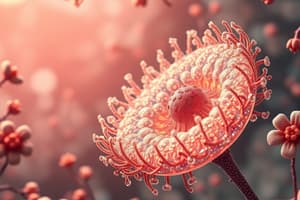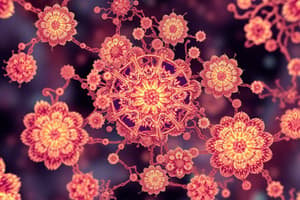Podcast
Questions and Answers
What distinguishes a prokaryotic cell from a eukaryotic cell?
What distinguishes a prokaryotic cell from a eukaryotic cell?
- Prokaryotic cells do not undergo cellular respiration.
- Eukaryotic cells are generally smaller.
- Eukaryotic cells have a nucleus. (correct)
- Prokaryotic cells have a nucleus.
What is the main purpose of cellular respiration?
What is the main purpose of cellular respiration?
- To store energy as fat.
- To convert sugars into proteins.
- To produce carbon dioxide and water.
- To generate energy for the cell. (correct)
Which line of defense do white blood cells represent in the immune system?
Which line of defense do white blood cells represent in the immune system?
- The fourth line of defense.
- Only the first line of defense.
- Only the third line of defense.
- Both the second and third lines of defense. (correct)
What is the correct order of the steps in the scientific method?
What is the correct order of the steps in the scientific method?
What is the role of the independent variable in an experiment?
What is the role of the independent variable in an experiment?
Which of the following accurately describes photosynthesis?
Which of the following accurately describes photosynthesis?
How many independent variables should be changed during a scientific experiment?
How many independent variables should be changed during a scientific experiment?
What is the first step in the life cycle of a virus?
What is the first step in the life cycle of a virus?
What defines the difference between an epidemic and a pandemic?
What defines the difference between an epidemic and a pandemic?
Which represents an example of indirect contact transmission?
Which represents an example of indirect contact transmission?
What is the primary role of ribosomes in both prokaryotic and eukaryotic cells?
What is the primary role of ribosomes in both prokaryotic and eukaryotic cells?
How do microbes negatively impact human health?
How do microbes negatively impact human health?
In the scientific method, what step follows 'Hypothesis'?
In the scientific method, what step follows 'Hypothesis'?
What does WHMIS stand for?
What does WHMIS stand for?
What is NOT a function of the cell membrane?
What is NOT a function of the cell membrane?
Which symbol indicates a poisonous substance?
Which symbol indicates a poisonous substance?
Which structures are unique to plant cells?
Which structures are unique to plant cells?
What component of the immune response involves white blood cells surrounding and killing pathogens?
What component of the immune response involves white blood cells surrounding and killing pathogens?
What is a key characteristic of eukaryotic cells?
What is a key characteristic of eukaryotic cells?
What occurs during the life cycle of a virus after it enters a host cell?
What occurs during the life cycle of a virus after it enters a host cell?
What distinguishes an endemic from an outbreak?
What distinguishes an endemic from an outbreak?
What characterizes the third line of defense in the immune system?
What characterizes the third line of defense in the immune system?
What differentiates a pandemic from an epidemic?
What differentiates a pandemic from an epidemic?
Which of the following vaccines typically require booster shots?
Which of the following vaccines typically require booster shots?
Which group stands to benefit the most from herd immunity?
Which group stands to benefit the most from herd immunity?
What is the primary function of white blood cells in the second line of defense?
What is the primary function of white blood cells in the second line of defense?
What role do memory white blood cells play in the immune system?
What role do memory white blood cells play in the immune system?
Which of the following statements correctly describes herd immunity?
Which of the following statements correctly describes herd immunity?
Which of the following best describes antibiotics?
Which of the following best describes antibiotics?
What is one of the key characteristics of living things?
What is one of the key characteristics of living things?
Why is it important to take flu shots annually?
Why is it important to take flu shots annually?
What is the primary distinction between rough ER and smooth ER?
What is the primary distinction between rough ER and smooth ER?
What happens to bacteria that grow mutations due to overconsumption of antibiotics?
What happens to bacteria that grow mutations due to overconsumption of antibiotics?
What is the basic unit of life?
What is the basic unit of life?
Which of the following pathways illustrates the connection between photosynthesis and cellular respiration?
Which of the following pathways illustrates the connection between photosynthesis and cellular respiration?
What does a control group do in an experiment?
What does a control group do in an experiment?
Which of the following vaccines is classified as a 'Live Attenuated' vaccine?
Which of the following vaccines is classified as a 'Live Attenuated' vaccine?
How does the first line of defense in the immune system operate?
How does the first line of defense in the immune system operate?
What characterizes superbugs?
What characterizes superbugs?
What is the primary reason for needing an annual flu vaccination?
What is the primary reason for needing an annual flu vaccination?
What does the term 'eukaryotic' refer to?
What does the term 'eukaryotic' refer to?
Which method is NOT used to kill pathogens in inactivated vaccines?
Which method is NOT used to kill pathogens in inactivated vaccines?
What component of a scientific method involves analyzing gathered data?
What component of a scientific method involves analyzing gathered data?
How do white blood cells respond to pathogens that breach the first line of defense?
How do white blood cells respond to pathogens that breach the first line of defense?
What type of vaccine is the hepatitis A vaccine?
What type of vaccine is the hepatitis A vaccine?
What happens during red tide?
What happens during red tide?
What is the primary function of antibiotics?
What is the primary function of antibiotics?
Which organelle is commonly referred to as the 'powerhouse' of the cell?
Which organelle is commonly referred to as the 'powerhouse' of the cell?
Which statement best describes why viruses are not considered alive?
Which statement best describes why viruses are not considered alive?
Flashcards
Cellular Respiration
Cellular Respiration
The process by which cells convert sugar (glucose) and oxygen into energy (ATP), carbon dioxide, and water.
White Blood Cells
White Blood Cells
These cells are responsible for defending the body against infections by identifying and destroying pathogens.
Independent Variable
Independent Variable
The factor that is intentionally changed by the experimenter to observe its effect on the dependent variable.
Photosynthesis
Photosynthesis
Signup and view all the flashcards
Virus
Virus
Signup and view all the flashcards
Specific vs. Non-Specific Immunity
Specific vs. Non-Specific Immunity
Signup and view all the flashcards
Scientific Method
Scientific Method
Signup and view all the flashcards
Hypothesis
Hypothesis
Signup and view all the flashcards
Pandemic
Pandemic
Signup and view all the flashcards
Epidemic
Epidemic
Signup and view all the flashcards
Transmission
Transmission
Signup and view all the flashcards
Direct Contact Transmission
Direct Contact Transmission
Signup and view all the flashcards
Indirect Contact Transmission
Indirect Contact Transmission
Signup and view all the flashcards
Food and Water Transmission
Food and Water Transmission
Signup and view all the flashcards
Animal Bite Transmission
Animal Bite Transmission
Signup and view all the flashcards
Ribosomes
Ribosomes
Signup and view all the flashcards
Microbe
Microbe
Signup and view all the flashcards
Positive Impact Of Microbes
Positive Impact Of Microbes
Signup and view all the flashcards
Negative Impact Of Microbes
Negative Impact Of Microbes
Signup and view all the flashcards
WHMIS
WHMIS
Signup and view all the flashcards
Cell Membrane Function
Cell Membrane Function
Signup and view all the flashcards
Ribosome
Ribosome
Signup and view all the flashcards
Herd Immunity
Herd Immunity
Signup and view all the flashcards
First Line of Defense
First Line of Defense
Signup and view all the flashcards
Second Line of Defense
Second Line of Defense
Signup and view all the flashcards
Third Line of Defense
Third Line of Defense
Signup and view all the flashcards
Memory B Cells
Memory B Cells
Signup and view all the flashcards
Antibiotics
Antibiotics
Signup and view all the flashcards
Superbugs
Superbugs
Signup and view all the flashcards
Live Attenuated Vaccine
Live Attenuated Vaccine
Signup and view all the flashcards
Inactivated Vaccine
Inactivated Vaccine
Signup and view all the flashcards
Subunit Vaccine
Subunit Vaccine
Signup and view all the flashcards
Toxoid Vaccine
Toxoid Vaccine
Signup and view all the flashcards
Control Group
Control Group
Signup and view all the flashcards
Constant Variable
Constant Variable
Signup and view all the flashcards
Subunit/Conjugate Vaccine
Subunit/Conjugate Vaccine
Signup and view all the flashcards
The Scientific Method
The Scientific Method
Signup and view all the flashcards
Microorganisms
Microorganisms
Signup and view all the flashcards
Eukaryotic
Eukaryotic
Signup and view all the flashcards
Study Notes
Prokaryotic vs. Eukaryotic Cells
- Eukaryotic cells have a nucleus; prokaryotic cells do not.
- Eukaryotic cells are significantly larger and more complex than prokaryotic cells.
Cellular Respiration
- Cellular respiration converts sugar and oxygen into carbon dioxide and water, releasing energy for life processes.
- This process occurs in both plant and animal cells, specifically within the mitochondria.
White Blood Cells (WBCs)
- WBCs are crucial for fighting pathogens.
- Without WBCs, the body's ability to fight off infections is severely weakened, potentially leading to death within the first few months of life.
- WBCs are part of the body's first, second, and third lines of defense.
- The first line of defense are the skin and internal lining.
- The second line of defense includes the white blood cells (WBCs) that surround and attack pathogens, and inflammation.
- The third line of defense includes specialized WBCs (B cells) that memorize pathogens to prepare for future attacks.
- Memory cells help to attack pathogens for the second time, preventing sickness from getting worse.
Virus Life Cycle
- A virus attaches to a host cell.
- The virus's genetic material enters the host cell.
- The host cell is tricked into producing more viral genetic material and proteins.
- New viruses are assembled inside the host cell.
- The host cell bursts, releasing new viruses.
Scientific Method
- Ask a question.
- Conduct background research.
- Form a hypothesis.
- Design and conduct an experiment.
- Evaluate the experiment's method (e.g., check if it’s working).
- Collect, analyze data.
- Draw a conclusion.
- Repeat (e.g., to eliminate errors).
Independent Variable
- The independent variable is the factor changed in an experiment, independent of other factors.
Photosynthesis
- Photosynthesis is a process in plant cells where sunlight, water, and carbon dioxide are converted into sugar and oxygen.
- Plants use the sugar for energy; the oxygen is released.
Modifying Variables in Experiments
- For a successful experiment, only one variable should be changed at a time.
Specific vs. Non-Specific Defenses
- First and second lines of defense are non-specific, defending against all pathogens.
- The third line of defense is specific, targeting particular pathogens that have evaded other defenses.
Pandemic vs. Epidemic
- An epidemic affects a specific geographic area.
- A pandemic is a global epidemic, spreading worldwide.
Transmission Methods
- Direct contact (e.g., shaking hands)
- Indirect contact (e.g., coughing without covering)
- Food and water (e.g., contaminated food)
- Animal bites (e.g., rabies)
Vaccine Types
- Live attenuated
- Inactivated
- Subunit
- Toxoid
Lines of Defense
- First line: Skin and linings (e.g., respiratory and digestive tracts).
- Second line: Non-specialized WBCs, inflammation.
- Third line: Specialized WBCs, develops immunity over time.
Booster Shots
- Booster shots are required for some toxoid vaccines because their protection is not as long-lasting as live attenuated vaccines.
Immunity
- Immunity is the body's ability to remember pathogens and destroy them quickly upon re-exposure.
Pathogen Benefits/Disadvantages
- Pathogen exposure can result in acquired immunity.
- Pathogens can cause sickness and disease.
Herd Immunity Beneficiaries
- All groups (elderly, young children, those with underlying conditions) benefit from herd immunity.
Flu Shots
- Annual flu shots are needed because the flu virus frequently mutates.
Photosynthesis/Respiration Relationship
- Photosynthesis and cellular respiration are part of a continuous cycle.
Herd Immunity Explanation
- Herd immunity occurs when a sizable portion of a community is vaccinated, limiting opportunities for spread to the unvaccinated.
- This protects vulnerable populations (elderly, children, immunocompromised).
Adult vs. Child Immunity
- Adults have more immunity than children because they've been exposed to more pathogens in their lifetime.
Vaccines Requiring Boosters
- Inactive, toxoid, and subunit vaccines often require booster shots.
Superbugs
- Superbugs are antibiotic-resistant bacteria.
- Bacteria become superbugs due to overuse of antibiotics, causing them to mutate.
Basic Unit of Life
- Cells
Antibiotics
- Antibiotics interfere with bacterial life processes.
Plant Oxygen Release
- Plants release oxygen as a byproduct of photosynthesis.
Cell Theory
- All living things are composed of cells.
- New cells arise only from pre-existing cells.
- Cells are the fundamental unit of life.
Living Things Characteristics
- Made of one or more cells.
- Take in nutrients and energy.
- Respond to stimuli.
- Grow.
- Reproduce.
- Produce waste.
Rough vs. Smooth ER
- Rough ER has ribosomes, involved in protein synthesis.
- Smooth ER lacks ribosomes, involved in lipid synthesis.
Memory WBCs
- Specialized WBCs that recognize previously encountered pathogens.
Photosynthesis/Cellular Respiration Relationship (Revised)
- Photosynthesis uses sunlight, water, and CO2 to produce sugar and oxygen.
- Cellular respiration uses the sugar and oxygen to produce energy, releasing CO2 and water. These products are then recycled in photosynthesis, creating a continuous cycle.
Lines of Defense (Expanded)
- First Line: Physical barriers (skin, respiratory and digestive tract linings). -Skin: Physical barrier, sweat & natural acid kill pathogens, waterproof for easy removal. -Linings: Hair and mucus trap pathogens, coughing/sneezing/swallowing remove pathogens. -Digestive: Acids kill many pathogens; vomiting removes pathogens.
- Second Line: Non-specific responses (WBCs, inflammation).
- WBCs surround and consume pathogens, release chemicals to signal others and fight.
- Inflammation: Redness and swelling to allow WBCs access.
- Third Line: Specific responses (specialized WBCs, memory cells, acquired immunity). -Specialized cells recognize and remember specific pathogens for faster and more efficient response in the future.
Herd Immunity (Revised)
- A high vaccination rate in a community reduces the ability of an infectious agent to spread, providing protection for those who cannot be vaccinated. This protects vulnerable groups (children, elderly, immunocompromised).
Epidemic/Pandemic
- Epidemic: A rapid increase in disease cases in a specific geographic area.
- Pandemic: An epidemic that has spread across multiple countries or continents.
Transmission Types (Revised)
| Transmission Method | Example |
|---|---|
| Direct Contact | Shaking hands, physical contact |
| Indirect Contact | Coughing without covering mouth, sharing objects |
| Contact with Food or Water | Contaminated food, water |
| Animal Bites | Animal bites from infected animals |
Graph Components
- Title, independent variable (x-axis), dependent variable (y-axis).
Control Group
- The control group displays the expected/typical result without the independent variable.
Constant Variable
- A constant variable remains unchanged throughout the experimental process.
Types of Vaccines (Examples)
| Vaccine Type | Examples |
|---|---|
| Inactivated | Rabies |
| Live Attenuated | Measles, chicken pox |
| Subunit/conjugate | Flu |
| Toxoid | Tetanus, diphtheria |
Calculating Magnification
- Eyepiece magnification x Objective magnification
Response to Pathogens (WBCs)
- Consume pathogens, release chemicals to attract other WBCs and signal other responses to kill pathogens.
Acquired Immunity
- Acquired over time through exposure or vaccination, which facilitates memory cells to quickly fight pathogens.
Microbes
- Small organisms visible only with a microscope. Can positively impact health through essential processes for digestion/food production. However, can also cause food spoilage, various diseases, and bacterial infections.
Scientific Method Steps (Expanded)
- Ask a Question
- Background Research
- Hypothesis: Educated prediction
- Experimentation
- Procedure Check: Is the method working?
- Data Collection & Analysis: Record results, organize, draw conclusions from data.
- Conclusion: Summarizing results, considering whether data supports hypothesis.
- Communicate Results: Share findings with others through presentations/publications.
Microorganisms Characteristics
- Only visible under a microscope.
Independent vs. Dependent Variables
- Independent Variable: The factor changed in an experiment.
- Dependent Variable: The factor affected by the independent variable.
Mitochondria
- The "powerhouse" of the cell, responsible for energy production.
Viruses: Non-living
- Viruses are not classified as living organisms due to their lack of cellular structure.
Plant Oxygen Release
- Oxygen is a byproduct of photosynthesis, where plants use sunlight, water, and carbon dioxide to produce food and oxygen.
Superbugs
- Antibiotic-resistant bacteria.
Eukaryotic
- Meaning: Having a true/proper nucleus.
Inactivated Vaccines: Pathogen Killing
- Killed with radiation, heat, or chemicals.
Antibodies
- Y-shaped proteins that bind to antigens, marking pathogens for destruction.
Immune System First Line
- Skin and internal linings.
Child vs. Adult Illness
- Children get sick more often because their immune systems are not fully developed. (developing/learning).
Red Tide
- Excessive phytoplankton reproduction leads to colored water and potential shellfish/human toxicity.
Positive Bacteria Examples
- Bacteria in saliva/digestive system, those supporting food production and/or used in vaccines or some medicines.
Studying That Suits You
Use AI to generate personalized quizzes and flashcards to suit your learning preferences.




